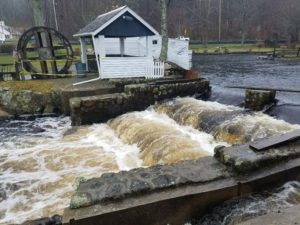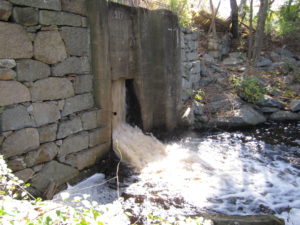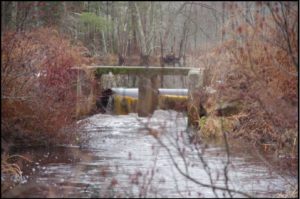The NSRWA is working with the towns of Duxbury and Marshfield, the Mass Division of Ecological Restoration and the MassBays Estuary Partnership, private dam owners and other stakeholders to holistically improve and restore the health of the South River and its habitat continuity for migrating species such as river herring, eel and shad as well as freshwater native species such as Eastern brook trout.
The restoration of the South River is complicated by existing residential and park development in the river’s floodplain and altered river flows from numerous dams along the river. Several studies of the impact of dam removal on river flows have been completed looking at Chandler Pond and Temple Street. More recent work has focused on working with the town of Marshfield and the veteran’s who maintain Veteran’s Park to remove the first dam from the ocean, while improving existing features of the park such as the lagoon, its associated fountain and a water wheel. Upstream in Duxbury we continue to investigate the feasiblity of removal of the Temple St dam with the town of Duxbury.
Background
The South River is a 15-mile river that with its headwaters at Round Pond in Duxbury. It flows through Duxbury and Marshfield, and is a tidal estuary to the first impediment, Veterans Memorial Park Dam, 8.8 miles from Massachusetts Bay. There are currently three dams on the South River mainstem along with multiple cranberry bogs. The South River has an active river herring and shad run as well as pockets of isolated Eastern brook trout in headwater tributaries.
Veterans Memorial Park Dam
 The first impediment on the South River is a dam at Veterans Memorial Park, 8.8 miles from the ocean, owned by the Town of Marshfield. It has a pool and weir fish ladder that passes very limited numbers of fish provided proper flow management occurs. Our current work here involves working with stakeholders including the town and Veteran’s who maintain the park, to remove the Veteran’s Park dam while maintaining the park features that honor our service men and women which includes the lagoon, fountain in the lagoon and a water wheel.
The first impediment on the South River is a dam at Veterans Memorial Park, 8.8 miles from the ocean, owned by the Town of Marshfield. It has a pool and weir fish ladder that passes very limited numbers of fish provided proper flow management occurs. Our current work here involves working with stakeholders including the town and Veteran’s who maintain the park, to remove the Veteran’s Park dam while maintaining the park features that honor our service men and women which includes the lagoon, fountain in the lagoon and a water wheel.
While working on a long term solution for improving fish passage at this site we continue to monitor the herring run and work with Mass. Division of Marine Fisheries and our partners in the town to ensure that adequate flows are provided for the fish ladder in the spring and fall and provide support for vegetation maintenance upstream to reduce flooding and allow for river herring passage.
Chandler Pond Dam
The next impedimen t to fish passage as one moves upstream is the privately-owned Chandler Pond dam, 9.5 miles upstream from the ocean. Chandler Pond has a primary spillway on a concrete dam structure that is controlled with flashboards, as well as a secondary outlet that provides an additional release during periods of high flows. These two outlets from the pond separate the South River into two stream channels that then reconnect downstream before the river flows into Veteran’s Park. Chandler Pond Dam is in poor shape, with vegetation including large trees on the dam crest and evidence of crumbling stonework and previous overtopping.
t to fish passage as one moves upstream is the privately-owned Chandler Pond dam, 9.5 miles upstream from the ocean. Chandler Pond has a primary spillway on a concrete dam structure that is controlled with flashboards, as well as a secondary outlet that provides an additional release during periods of high flows. These two outlets from the pond separate the South River into two stream channels that then reconnect downstream before the river flows into Veteran’s Park. Chandler Pond Dam is in poor shape, with vegetation including large trees on the dam crest and evidence of crumbling stonework and previous overtopping.
A 2015 study, paid for by the state’s Division of Ecological Restoration office, examined the impacts on the South River’s flow from Chandler Pond down to Veterans Memorial Park under existing and alternative dam removal scenarios. The study showed that the Veteran’s Park dam has a backwatering effect particularly in smaller storm events, flood heights would be reduced at 60 Cross St under some dam removal scenarios but under no scenario would flooding be eliminated, and the Ellis bog can contribute to flooding at this same property.
Temple Street Dam
 The Town of Duxbury owns this small dam off Temple Street and would like to remove it if feasible to reduce maintenance (beavers like to build up the dam further) and to improve fish habitat. The Temple Street dam consists of an earthen berm with a 2-chamber concrete spillway. A tributary to the South River, Phillips Brook, enters upstream of Temple Street dam and has been documented as brook trout habitat by Mass. Division of Fisheries and Wildlife.
The Town of Duxbury owns this small dam off Temple Street and would like to remove it if feasible to reduce maintenance (beavers like to build up the dam further) and to improve fish habitat. The Temple Street dam consists of an earthen berm with a 2-chamber concrete spillway. A tributary to the South River, Phillips Brook, enters upstream of Temple Street dam and has been documented as brook trout habitat by Mass. Division of Fisheries and Wildlife.
Feinberg and Garside Bogs
The Feinberg Bog was acquired in 1971 by the Town of Duxbury as 100 acres of conservation land and contains ~0.3 miles of stream. The bog has flumes at the upstream and downstream end; the berm adjacent to the downstream flume has failed due likely to overtopping and clogging due to beaver activity. The 61-acre Garside Bogs were acquired by the Town of Duxbury for conservation land in 1979. There are upstream and downstream flumes at this site that could potentially cause impediments to flow should they collapse. Much like the Feinberg Bogs and Temple St. Dam, the Garside Bog flumes are popular frameworks for beavers constructing dams, and there is ample evidence onsite of repeated flow restoration efforts through beaver dam removal.
- 2025 WaterWatch Lecture Series
- Education
- 2024 WaterWatch Lecture Series
- Community Programs
- Estuary Explorers
- River Adventures Camp
- School Programs
- Workshops and Conferences
- Healthy Rivers
- Dam Removals
- Indian Head River Restoration
- South River Restoration
- South River Restoration
- Third Herring Brook Restoration
- Improving Water Quality
- Shellfish Beds
- Streamflow Restoration
- First Herring Brook Restoration
